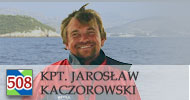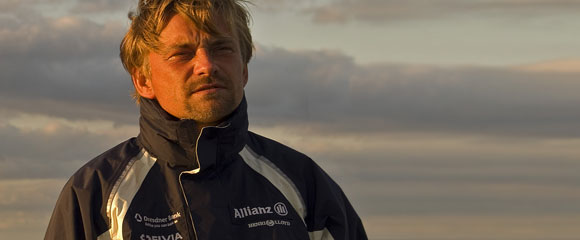Capt. Kaczorowski's first account after completing the first leg of the race:
 August 8th, 2006 August 8th, 2006
When completely worn out with two ragged spinnakers, a broken centerboard and almost out of power I reached the finishing line on August 8th, I was convinced that it was the biggest nightmare of all I had during this regatta. When I finally had some good sleep and went to the marina, I heard from other colleagues such bloodcurdling stories that I can regard myself lucky. Broken masts, rudders, spinnaker booms, one yacht on rocks. A few boats looked like after a war.
First 24 hours
During first 24 hours the wind was very week. I haven't find the way of sailing fast in the flattering week, thus a lot of boats overtook me. On the second day, however, an atmospheric front came along with a strong wind, so I flooded the ballast tank, turned the keel, took the rudder in my hands and all night long I was fighting with the wind of nearly 35 kn. A few boats didn't survive. In our class tacking with the wind of just 20 kn means struggling for life. This night I had a bad weather. I turned the autohelm on for a while and went under the deck. During my absence there was a strong gust of wind. My boat listed heavily and at that moment a huge wave stuck me on the side. The autohelm didn't managed to keep the course: jib to windward, ballast and keel to leeward, wind force of 35 kn, left deck under water. It looked pretty badly when I jumped on the deck with a front lamp and a knife in my hand. Fortunately, nothing fell off. I had to control the rudder till the end of the night.
Strong wind and charging batteries
During the next two days the wind was rather flattered. When I passed Cabo Finisterre it started to blow stronger in the back. I tried to set the heavy spinnaker. When everything was ready the bow dived under the water and it pulled the sail out of the bag overboard. I had to drop the main sail, cut off one of the ropes. And it took me half an hour to hoist the sail aboard. Unfortunately, it got torn during this operation. For a big 80 meters long spinnaker there was too much wind. I set the genaker, but it didn't perform as well as the spinnaker did. At night I tried to charge the batteries but after three hours the loader gave me only two amperes. I knew that no sun means trouble (my solar battery can give me twenty amperes during sunshine). And I was in trouble indeed. There was only one shinny day during the race.
A roller-coaster
On the next day the wind eased up to 15-20 kn, so I set the big spinnaker. I was like a ride on a roller-coaster! The speed seldom dropped under 9 knots. Sometimes it even reached 14 knots. In the beginning, I was a bit horrified wondering what will happen first: the mast extracts from the yacht or a spinnaker explodes. However, after an hour nothing came off, so I decided to rush ahead till the evening. When the wind force reached 25 kn, the bow got under the water a few times what looked quite dangerously. It cost me a lot of effort to pull the spinnaker down, set the reacher and go under the deck to charge the batteries.
In the middle of the Ocean with a knife in a hand
The next day it started to blow stronger, thus I set my 80 meters long "beast". All day long I was surfing waves with a great joy, although every 2-3 hours I had a small crisis almost trying not to fall asleep behind the rudder. Until evening I was sailing pretty fast, but that day my luck abandoned me. The wind force rose to 25-28 kn and I couldn't wait when it stops. After five dives when the boat got into the water up to the mast and I almost had an uncontrolled stern (we call that "Chinese") I decided to risk and collapse the spinnaker. The autohelm was not able to steer. I got into a beam reach, list 80 degrees and a terrible bang of flapping spinnaker. In one hand I was grasping railing in order not to fall on leeward, one leg I put against a winch on the forecastle, then I opened my knife and started to wonder whether I should cut a halyard first or a clew to save the sail. I had an impression the situation was rather peculiar: I was several hundred miles form the shore standing with a knife in my hand on almost overturned boat too small for such a wind and the Ocean. After a while, the spinnaker got ragged, so I dropped it into the water. Then it took me almost half an hour to hoist it. I was like a fisherman who draws his nets into the boat. Till the end of the race, I could only sail setting reacher and jib.
Finish
Just before the finishing line I fought a battle with two yachts. Just like on a normal regatta. Completely worn out after several hours of steering for the last five days I crossed the finishing line. I let the sailors from the local club drag me to the port and went to sleep on a normal bed.
The next day I heard some stories from other Mini sailors and came to conclusion that my adventures were not that unusual. I now understand after this leg why Mini Class sailors are so respected in France.
On Tuesday we are returning. I hope that according to today's weather forecast, it will be quite windy. Then I am pretty fast in comparison to many boats. It won't be a pleasure, but for pleasure I will be sailing in Autumn in Croatia. Then I won't have to race or touch the rudder either.
Capt. Jarosław Kaczorowski
In the prototype class Capt. Kaczorowski is ranked 21. The leader is Adrien Hardy aboard 198 Brossard. On August 15th after a few days of rest the sailors are to start the second leg. The fleet of Minis will then return for France. On August 24th first Minis are expected to cross the finishing line in Les Sables.
Jaro together with his crew Marek Gałkiewicz, who flew to Azores loaded down with tools and spare parts (unfortunately, there wasn't a spare keel among them) will be quite busy over the next few days preparing the boat for the next 1270 NM of a single-handed race.
 Translated by Anna Greczuk Translated by Anna Greczuk
|





